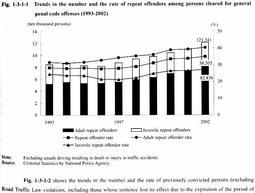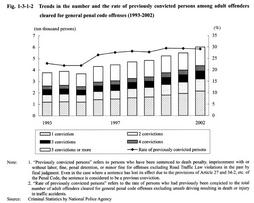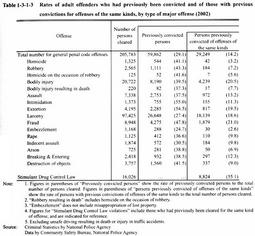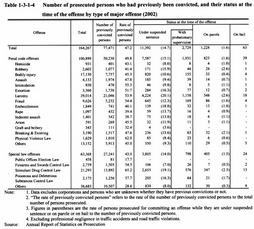| Previous Next Index Image Index Year Selection | |
|
|
Fig. 1-3-1-1 shows the trends in the number and the rate of adult and juvenile repeat offenders (people who had previously been cleared for committing an offense and were cleared again; hereinafter the same in this section) to the total of offenders cleared for general penal code offenses over the last 10 years.
In 2002, the number of repeat offenders was 121,341, accounting for 34.9% of the total cleared. Both the number and the rate have risen since 1997. The number and the rate of adult repeat offenders have risen since 1996 and 1995, reaching 82,836 and 40.3% in 2002 respectively. In particular, the rate of repeat offenders has risen remarkably by 9 points from the 31.0% in 1994 (for the trends of juvenile offenders, see the next section). Fig. 1-3-1-1 Trends in the number and the rate of repeat offenders among persons cleared for general penal code offenses (1993-2002) Fig. 1-3-1-2 shows the trends in the number and the rate of previously convicted persons (excluding Road Traffic Law violations, including those whose sentence lost its effect due to the expiration of the period of suspension of execution of sentence; hereinafter the same in this chapter) to the total number of adult offenders cleared for general penal code offenses over the last 10 years. In 2002, the number of previously convicted persons was 59,862, accounting for 29.1%. Those with 1 previous conviction had the largest share, accounting for about 1/3rd of all previously convicted persons. Since 1996, both the number and the rate of previously convicted persons have been on the rise, with a significant increase for those with 1 previous conviction.Fig. 1-3-1-2 Trends in the number and the rate of previously convicted persons among adult offenders cleared for general penal code offenses (1993-2002) Table 1-3-1-3 shows the numbers and the rates of persons previously convicted and of those with previous convictions of offenses of the same kinds to the total number of persons cleared in 2002, by type of major offense. The rate of those previously convicted was 29.1% among all persons cleared for general penal code offenses whereas it exceeded 50% among those cleared for intimidation and extortion, and 40% for homicide, robbery, robbery resulting in death, fraud, and destruction of objects. The rate of those with previous conviction of offenses of the same kinds was 14.2% among all persons cleared for general penal code offenses whereas it exceeded 20% among those cleared for fraud and bodily injury, and nearly reached 20% among those cleared for extortion and larceny. 55.1% of those cleared for Stimulant Drug Control Law violations had previously been cleared for the same offense.Table 1-3-1-3 Rates of adult offenders who had previously been convicted and of those with previous convictions for offenses of the same kinds, by type of major offense (2002) Table 1-3-1-4 shows the number and the rate of those persons who had previously been convicted to the total number of persons prosecuted in 2002, and their status at the time of the offense (under suspended sentences, on parole, or on bail) by type of major offense. The rate of previously convicted persons was 47.2% among all persons prosecuted whereas it exceeded 60% among those prosecuted for Physical Violence Law violations and Stimulant Drug Control Law violations. The rate of while those were under suspended sentence was 14.7% among those previously convicted who were prosecuted for committing an offense, whereas it nearly reached 20% among those prosecuted for larceny, Stimulant Drug Control Law violations, and embezzlement.Table 1-3-1-4 Number of prosecuted persons who had previously been convicted, and their status at the time of the offense by type of major offense (2002) |



